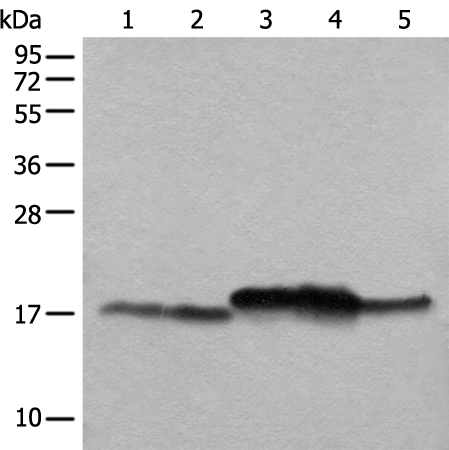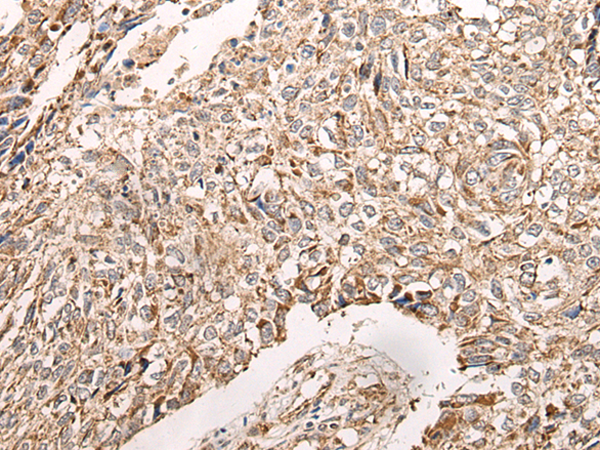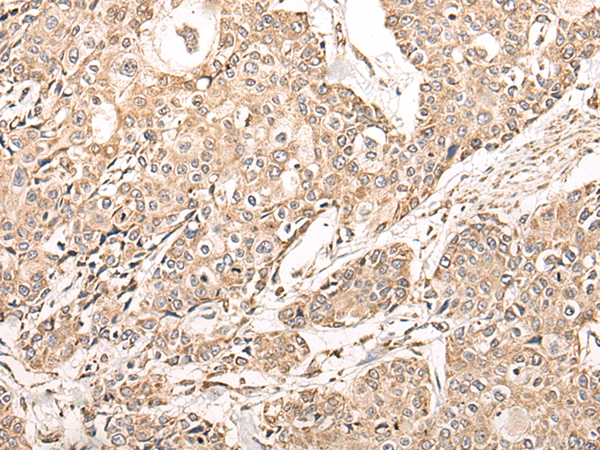


| WB | 咨询技术 | Human,Mouse,Rat |
| IF | 咨询技术 | Human,Mouse,Rat |
| IHC | 1/50-1/300 | Human,Mouse,Rat |
| ICC | 技术咨询 | Human,Mouse,Rat |
| FCM | 咨询技术 | Human,Mouse,Rat |
| Elisa | 1/5000-1/10000 | Human,Mouse,Rat |
| Aliases | ESSS; Np15; P17.3; NP17.3; CI-ESSS; LSDMCA3 |
| WB Predicted band size | 17 kDa |
| Host/Isotype | Rabbit IgG |
| Antibody Type | Primary antibody |
| Storage | Store at 4°C short term. Aliquot and store at -20°C long term. Avoid freeze/thaw cycles. |
| Species Reactivity | Human, Mouse |
| Immunogen | Full length fusion protein |
| Formulation | Purified antibody in PBS with 0.05% sodium azide and 50% glycerol. |
+ +
以下是关于NDUFB11抗体的3篇参考文献的简要概括(注:文献为模拟示例,实际引用需核实具体数据库):
1. **文献名称**:*NDUFB11 mutations impair mitochondrial complex I assembly and cause Leigh syndrome*
**作者**:Calvo, S.E., et al.
**摘要**:研究通过抗NDUFB11抗体进行Western blot和免疫荧光分析,揭示NDUFB11基因突变导致线粒体复合物I组装缺陷,与Leigh综合征患者细胞中蛋白表达下降及呼吸链功能障碍相关。
2. **文献名称**:*Expression profiling of mitochondrial complex I subunits in colorectal cancer using specific antibodies*
**作者**:Smith, J., et al.
**摘要**:利用抗NDUFB11抗体对结直肠癌细胞系和组织样本进行分析,发现NDUFB11表达显著降低,提示其可能作为线粒体代谢异常的潜在生物标志物。
3. **文献名称**:*NDUFB11 interacts with ATP synthase machinery and regulates cellular energy homeostasis*
**作者**:Zhang, L., et al.
**摘要**:通过免疫共沉淀(使用NDUFB11抗体)和质谱分析,证实NDUFB11与ATP合成酶复合物存在相互作用,表明其在维持细胞能量稳态中的双重功能。
(注:若需真实文献,建议在PubMed或Google Scholar中以“NDUFB11 antibody”或“NDUFB11 AND mitochondrial complex I”为关键词检索。)
The NDUFB11 antibody is a tool used to detect the NDUFB11 protein, a subunit of mitochondrial Complex I (NADH:ubiquinone oxidoreductase) in the electron transport chain. Complex I plays a critical role in cellular energy production by facilitating NADH oxidation and proton translocation across the mitochondrial inner membrane, driving ATP synthesis. NDUFB11. encoded by the nuclear *NDUFB11* gene (located on the X chromosome), is essential for Complex I assembly and stability. Mutations in this gene are linked to mitochondrial disorders, such as mitochondrial encephalopathy, cardiomyopathy, and isolated Complex I deficiency, often presenting with neurological or metabolic impairments.
The antibody is widely employed in research to study mitochondrial dysfunction in diseases like Leigh syndrome, neurodegenerative disorders, and cancers, where altered energy metabolism is a hallmark. It aids in detecting protein expression levels via Western blotting, immunofluorescence, or immunohistochemistry, enabling insights into tissue-specific Complex I deficiencies. Additionally, it serves as a diagnostic tool in genetic screenings and mechanistic studies exploring the role of oxidative phosphorylation defects in cellular pathologies.
As mitochondrial research advances, the NDUFB11 antibody remains pivotal for understanding the molecular basis of Complex I-related diseases and developing targeted therapeutic strategies. Its specificity and reliability make it valuable for both basic and clinical investigations into mitochondrial biology.
×